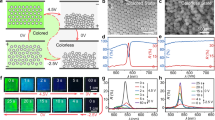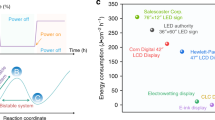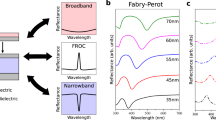Abstract
In our information-rich world, it is becoming increasingly important to develop technologies capable of displaying dynamic and changeable data, for reasons ranging from value-added advertising to environmental sustainability. There is an intense drive at the moment towards paper-like displays, devices having a high reflectivity and contrast to provide viewability in a variety of environments, particularly in sunlight where emissive or backlit devices perform very poorly. The list of possible technologies is extensive, including electrophoretic, cholesteric liquid crystalline, electrochromic, electrodewetting, interferometric and more. Despite tremendous advances, the key drawback of all these existing display options relates to colour. As soon as an RGB (red, green and blue) colour filter or spatially modulated colour scheme is implemented, substantial light losses are inevitable even if the intrinsic reflectivity of the material is very good.
This is a preview of subscription content, access via your institution
Access options
Subscribe to this journal
Receive 12 print issues and online access
$209.00 per year
only $17.42 per issue
Buy this article
- Purchase on Springer Link
- Instant access to full article PDF
Prices may be subject to local taxes which are calculated during checkout




Similar content being viewed by others
References
Yablonovitch, E. Inhibited spontaneous emission in solid-state physics and electronics. Phys. Rev. Lett. 58, 2059–2062 (1987).
John, S. Strong localization of photons in certain disordered dielectric superlattices. Rev. Lett. 58, 2486–2489 (1987).
Schroden, R. C., Al-Daous, M., Blanford, C. F. & Stein, A. Optical properties of inverse opal photonic crystals. Chem. Mater. 14, 3305–3315 (2002).
Lopez, C. Materials aspects of photonic crystals. Adv. Mater. 15, 1679–1704 (2003).
Arsenault, A. et al. Towards the synthetic all-optical computer: Science fiction or reality? J. Mater. Chem. 14, 781–794 (2004).
Arsenault, A. C., Miguez, H., Kitaev, V., Ozin, G. A. & Manners, I. A polychromic, fast response metallopolymer gel photonic crystal with solvent redox tunability: A step towards photonic ink (P-Ink). Adv. Mater. 15, 503–507 (2003).
Stober, W., Fink, A. & Bohn, E. Controlled growth of monodisperse silica spheres in the micron size range. J. Colloid Interface Sci. 26, 62–69 (1968).
Jiang, P., Bertone, J. F., Hwang, K. S. & Colvin, V. L. Single-crystal colloidal multilayers of controlled thickness. Chem. Mater. 11, 2132–2140 (1999).
Hoyle, C. E., Lee, T. Y. & Roper, T. Thiol-enes: Chemistry of the past with promise for the future. J. Polym. Sci. Part A – Polymer Chem. 42, 5301–5338 (2004).
Asher, S. A., Holtz, J., Liu, L. & Wu Z. J. Self-assembly motif for creating submicron periodic materials. Polymerized crystalline colloidal arrays. J. Am. Chem. Soc. 116, 4997–4998 (1994).
Holtz, J. H., Holtz, J. S. W., Munro, C. H. & Asher, S. A. Intelligent polymerized crystalline colloidal arrays: Novel chemical sensor materials. Anal. Chem. 70, 780–791 (1998).
Saito, H., Takeoka, Y. & Watanabe, M. Simple and precision design of porous gel as a visible indicator for ionic species and concentration. Chem. Commun. 2126–2127 (2003).
Jethmalani, J. M. & Ford, W. T. Diffraction of visible light by ordered monodisperse silica–poly(methyl acrylate) composite films. Chem. Mater. 8, 2138–2146 (1996).
Fudouzi, H. & Xia, Y. N. Photonic papers and inks: Color writing with colorless materials. Adv. Mater. 15, 892–896 (2003).
Jiang, P., Smith, D. W., Ballato, J. M. & Foulger, S. H. Multicolor pattern generation in photonic bandgap composites. Adv. Mater. 17, 179–184 (2005).
Takeoka, Y. & Watanabe, M. Tuning structural color changes of porous thermosensitive gels through quantitative adjustment of the cross-linker in pre-gel solutions. Langmuir 19, 9104–9106 (2003).
Rulkens, R. et al. Linear oligo(ferrocenyldimethylsilanes) with between two and nine ferrocene units: Electrochemical and structural models for poly(ferrocenylsilane) high polymers. J. Am. Chem. Soc. 118, 12683–12695 (1996).
Arsenault, A. C. et al. Vapor swellable colloidal photonic crystals with pressure tunability. J. Mater. Chem. 15, 133–138 (2005).
Acknowledgements
A.C.A. would like to thank the Natural Sciences and Engineering Research Council of Canada (NSERC) for a CGS scholarship. I.M. thanks the European Union for a Marie Curie Chair, the Royal Society for a Wolfson Research Merit Award (2005), and the Canadian Government for a Canada Research Chair. G.A.O. thanks the Government of Canada for a Research Chair in Materials Chemistry. The authors would like to thank G. Masson and D. Rider for help with polymer synthesis, and V. Kitaev for providing monodisperse microspheres. The authors would like to thank Materials and Manufacturing Ontario (MMO), NSERC, the Government of Canada and the University of Toronto for generous funding.
Author information
Authors and Affiliations
Contributions
A.C.A. and G.A.O. conceived the experiments; D.P.P. and A.C.A. performed the experiments; A.C.A., D.P.P., G.A.O. and I.M. analysed the experimental results; A.C.A. wrote the manuscript.
Corresponding authors
Ethics declarations
Competing interests
Since submission of this paper, the described technology is being developed by Opalux, a spin-off company based on research begun at the University of Toronto.
Rights and permissions
About this article
Cite this article
Arsenault, A., Puzzo, D., Manners, I. et al. Photonic-crystal full-colour displays. Nature Photon 1, 468–472 (2007). https://doi.org/10.1038/nphoton.2007.140
Received:
Accepted:
Published:
Issue Date:
DOI: https://doi.org/10.1038/nphoton.2007.140
This article is cited by
-
Hyperreflective photonic crystals created by shearing colloidal dispersions at ultrahigh volume fraction
Microsystems & Nanoengineering (2024)
-
High-speed laser writing of structural colors for full-color inkless printing
Nature Communications (2023)
-
Photonic structures in radiative cooling
Light: Science & Applications (2023)
-
A reflective display based on the electro-microfluidic assembly of particles within suppressed water-in-oil droplet array
Light: Science & Applications (2023)
-
Electrically responsive photonic crystals with bistable states for low-power electrophoretic color displays
Nature Communications (2022)



